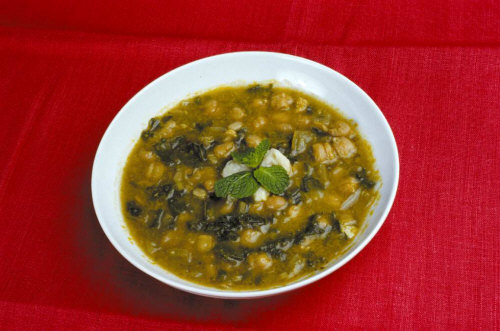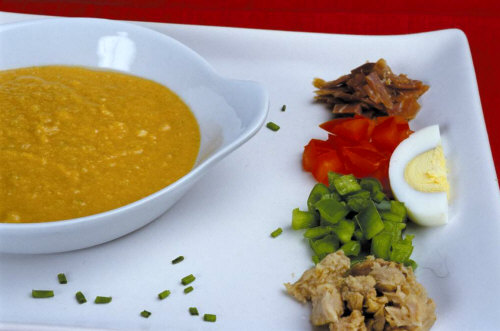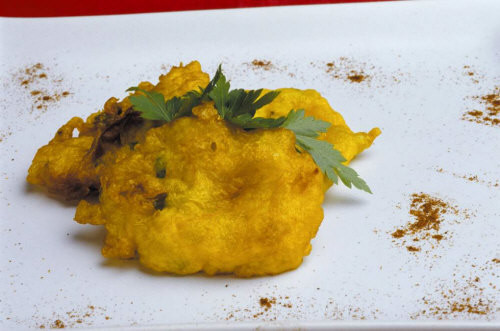|

As is to be supposed, the
gastronomy of the Sierra de las
Nieves is based on the richness
and variety of the local produce
and the vast quantity of fruit
and wild products from the
mountains. Meat, seasonal fruit
and vegetables of all kinds,
olives, almonds and figs,
cereals and an endless selection
of beans and pulses, are served
with asparagus, mushrooms,
edible thistles, an infinity of
aromatic plants, or wild fruits
and berries, and of course the
prized and highly tasty pieces
of game. History, tradition,
ingenuity and even, at times,
necessity, have been able to
combine all these excellent raw
materials to obtain results that
are “finger-licking good”.

Cabbage
Sierra de las Nieves offers
almost all of the dishes typical
of universal Mediterranean
cuisine in which the omnipresent
olive is the basic ingredient.
Salads, scrambled eggs with
asparagus or mushrooms,
pork-based charcuterie products,
and goats’ cheese are usually
found in the first course. The
traditional thick soups, hotpot,
casserole, the different soups
or cold gazpacho in summer are
the main alternatives when it
comes to choosing how to begin
your meal.
For the second course, roast or
stewed meat, whether pork, baby
goat or lamb, flavoured with
herbs from the Sierra, are
predominant, although there are
also some well-known recipes
using fish from the nearby
coast.
To finish, as a sweet, there is
a rich variety of tarts,
pastries, sponge cakes,
fritters, patties,
honey-fritters, biscuits, all
home-made and based on almonds,
chestnuts, walnuts and honey
from the region.
But out of all of this great
variety of dishes, many of which
are common to the cuisine of
Malaga, Andalusia or the
Mediterranean, there are some
plates that are special and
exclusive to these villages.
Dishes and recipes that
demonstrate the special culinary
know-how that has been handed
down from mothers to daughters,
thus conserving the preparation
and presentation of their
completely home-made origin.
These dishes, which until
recently were only to be found
in the homes of the locals,
appear more and more on the
menus of restaurants, permitting
visitors to become more familiar
with the flavours of the Sierra
de las Nieves.

Rosco
The first example could be
olives in marinade. In some of
the villages of the Sierra de
las Nieves the table is never
laid without putting a plate of
olives split and dressed in the
traditional way. The variety
that is cultivated in the
villages is the olive known as
“manzanilla” which, once split
and sweetened in brine, is then
dressed with olives, fennel,
thyme and pieces of red pepper.
Alozaina and Casarabonela are
large producers of this variety
of olive for preparing this way,
although they are also to be
found in the rest of the
villages. Also
worthy of mention are the soups.
Almost all the villages have
their own typical and
traditional recipes, one of
which is based on the bread left
over from the day before. The
various added ingredients,
special to each village, give
the soup its own personality.
The best known are the so-called
“sopas hervías con espárragos”,
(soup with asparagus), soup
Mondeña (from Monda), “caldo pon
cima” in Alozaina, soup of “los
siete ramales” in El Burgo or
corn (on or off the cob) soup in
Istán. In many cases, the custom
is for these soups to be the
only dish served for lunch,
accompanied by bits of cucumber,
onion, melon and even oranges.
Another special dish is the
pipeo, very typical and
traditional in Casarabonela,
although is also frequently
found in other nearby villages.
The main ingredient of this dish
is the tender young broad beans,
which are cooked together with
lettuce and a number of other
fresh products from the kitchen
garden. The result is inevitably
delicious.

Porra
Also frequent in the range of
first courses is the gazpachuelo
from Málaga, which contains
breadcrumbs, rice, potato and
also some pieces of fish,
depending on the variety.
Whilst spicy chorizo sausage,
morcilla (black pudding) and
salchichón are traditionally
made from parts of pork in the
butchers’ shops of all the
villages, the most emblematic is
the morcón. A large pork
intestine is filled with pork
loin to which is added the
filling of the black sausage or
the chorizo, all cooked
together. The result, apart from
being spectacular, is extremely
succulent.
Also originating from livestock
activity, is a very special dish
served on holiday occasions. The
caldereta is a casserole in
which bay leaves, pepper and
wine give a special touch to the
goat meat, often served with
potatoes. In Yunquera this stew
is never absent from the table
in any feast day or celebration
worth mentioning.
Game dishes are particularly
appreciated. Rabbit and
partridge, casseroled or
roasted, retain the flavour of
the mountain through the use of
a wide range of aromatic herbs
used in the recipes. Several
restaurants specialize in these
dishes.

To accompany these dishes, or
simply to drink while having
tapas, the ideal is the mosto
wine from Tolox or Yunquera.
These young wines, will very low
alcohol content are still
produced entirely by traditional
methods on hand-worked
wine-presses, and are stored in
large barrels in the
wine-cellars of the old bars
still found in the villages.
Sweets and desserts also have
their own personality. Some of
the better know are the almond
desserts from Guaro. Tarts,
little doughnuts, sponge-cake
and biscuits made in the same
way for centuries, have as a
basic ingredient this fruit that
is so widely cultivated in the
area. Fresh goat’s cheese
accompanied by cane sugar from
the Sierra is another of the
most traditional and popular
desserts.
RECIPES FOR DOWNLOADING
|